Galkans
Galkic: Galkan /gɑːlkhɑːn/
Dalran: Vakanere Rexlas: Kalgei
The galkans1 are natives to the savanna of Vagalkan in northern Túlmikkía, their civilization is among the most ancient in Gætíus' World and the longest continuous one, dating back the chalcolithic era.
They are related to Orrólans and Namki to the west and south respectively and -more distantly- the Enans, Akalúrans and Þekkals of southeastern Emlas.
The name is derived from galkan, meaning The River People. [h1History Galkan civilization is the oldest in Túlmikkía, and despite severe droughts, devastating floods, numerous wars among themselves and against their neighbours throughout their history, it never experienced a collapse like many other ancient cultures of Gætíus' World, such as the Káaxans, Ilaxarans and Memnans of old. As a result, their culture is quite advanced in some fields while still preserving certain aspects more typical of a bronze age society.
Each kingdom is ruled by a king or hút-ol (sun's likeness) and queen (kahe-ol or 'moon's likeness), with local chiefs, priests, priestesses and the royal family forming an aristocracy known as vóha-na (children of the morning star) while commoners are referred to as lakó-na or 'children of the evening star'.
Traditionally, tobacco is burned as incense to keep evil spirits (and insects) before eating.
Dalran: Vakanere Rexlas: Kalgei
The galkans1 are natives to the savanna of Vagalkan in northern Túlmikkía, their civilization is among the most ancient in Gætíus' World and the longest continuous one, dating back the chalcolithic era.
They are related to Orrólans and Namki to the west and south respectively and -more distantly- the Enans, Akalúrans and Þekkals of southeastern Emlas.
The name is derived from galkan, meaning The River People. [h1History Galkan civilization is the oldest in Túlmikkía, and despite severe droughts, devastating floods, numerous wars among themselves and against their neighbours throughout their history, it never experienced a collapse like many other ancient cultures of Gætíus' World, such as the Káaxans, Ilaxarans and Memnans of old. As a result, their culture is quite advanced in some fields while still preserving certain aspects more typical of a bronze age society.
Society
Galkans are currently divided into several kingdoms, the most powerful of which are Nonón along the Kíva River to the west, Kosjal along the Ap River in central Vagalkan and Ir-Sjún along the Jahó River to the east.Each kingdom is ruled by a king or hút-ol (sun's likeness) and queen (kahe-ol or 'moon's likeness), with local chiefs, priests, priestesses and the royal family forming an aristocracy known as vóha-na (children of the morning star) while commoners are referred to as lakó-na or 'children of the evening star'.
Culture
Apparel
Galkan clothes are predominantly made of linen or animal skins, the former being more common in towns and cities while the latter are often worn by the rural population, while feather cloaks are only worn by high priests. Men generally wear little more than loincloth, while women wear long, sleeveless dresses held by shoulder straps, which is consistent among commoners and nobles alike, the only real difference being the quality of the material and dyes.
Most jewelry -particularly bracelets, anklets and necklaces- is made of copper (believed to have mystical properties), gold or painted wooden or soapstone beads, those of high status also adorn themselves with feathers.
Galkan men generally shave their beards, sometimes leaving a small patch on their chin, while both men and women shave their hair in a similar fashion; women usually leave a lock of hair on either side or top of their head, while men have short lock on their forehead and sometimes a mohawk of varying length as well. The latter is especially popular among warriors.
All galkans wear black face-paint around the eyes, imitating the markings on the heads of local falcons, both as protection against the glare of the sun as well for apotropaic purposes. Body-paint in form of yellow stripes are common as well.
Galkan men generally shave their beards, sometimes leaving a small patch on their chin, while both men and women shave their hair in a similar fashion; women usually leave a lock of hair on either side or top of their head, while men have short lock on their forehead and sometimes a mohawk of varying length as well. The latter is especially popular among warriors.
All galkans wear black face-paint around the eyes, imitating the markings on the heads of local falcons, both as protection against the glare of the sun as well for apotropaic purposes. Body-paint in form of yellow stripes are common as well.
Art
Architecture
Most buildings, from the humblest homes to royal palaces, are made of wood and clay with thatched roofs, the main difference being that the walls of the latter are often painted with geometric motifs and feature large courtyards serving as throne rooms. Monumental structures also feature sun-baked mud bricks as well. The most distinct aspect of galkan architecture, however, is that temples and palaces are built on top of huge mounds of rammed earth and accessed via stairways.Sculptures
Galkans are renowned for their statuettes made of wood, copper or gold, often featuring deities or religious symbols for use in family shrines and temples alike.Cuisine
Yellow, red and white maize is staple food of the galkans along with beans, sunflower seeds, fish, turkey, beef and wild game. Dates, water lilies, yellow nutsedge and sesame seeds are also commonly eaten in some regions. Corn beer is the main beverage.Traditionally, tobacco is burned as incense to keep evil spirits (and insects) before eating.
Language
The galkan writing system is one of the world's oldest, based on hieroglyphs where each sign represent a certain concept or sound, the latter is a relatively recent development. It's the ancestor of quite a few scripts, including the orrólan one, who simplified the glyphs for to make writing faster, the Enans developed it further into a full-fledged alphabet which has since been adopted and adapted by a variety of cultures in eastern Emlas and Laxilþía.Religion
Galkan religion revolves around a large pantheon of deities, each of which has a statue housed in a temple and believed to be a living being. A major part of the life of priests and priestesses is to ensure these divine statues are taken good care of by washing them, giving offerings of food, drink and incense, and entertained with music, hymns and ritual dancing. Deities are traditionally depicted either humans with features related to their associated animals or in entirely animal form.
Many of these ceremonies are attended or performed by the monarch of each kingdom, while commoners are only allowed to witness some of these rituals or partake indirectly through festivities in honour of the gods.
Many of these ceremonies are attended or performed by the monarch of each kingdom, while commoners are only allowed to witness some of these rituals or partake indirectly through festivities in honour of the gods.
Major deities
Hjeka-te
Hjeka-te is the divine bull, associated with the moon and agriculture.Hút
Hút is god of the sun, protector of kings and associated with coming-of-age ceremonies for boys.Kahe
Kahe is goddess of the moon, protector of queens and associated with coming-of-age ceremonies for girls.Kehavó
Kehavó is the divine cheetah, associated with thunderstorms, water and metallurgy.Móhe-ka
Móhe-ka is the divine falcon, associated with strength and warfare.Nefó-ava
The divine serpent, associated with healing and the underworld.Peva-sja
The divine cow, main fertility goddess of the galkans and associated with festivities.Tólka
The divine stag, messenger of the gods and protector of travelers.Heroes
Lakó and Vóha
Culture heroes who taught galkans valuable skills such as weaving, agriculture and writing, and upon their death the gods turned Vóha into the morning star and Lakó into the evening star.Funerary practices
The fate of the soul in galkan religion depends on the person's status in life: only the king and queen are believed to live among the gods after death, those belonging to the aristocracy are guaranteed a good afterlife, a fate which only awaits commoners who have done good deeds in their life. Others are variously believed to become wandering spirits, reborn as certain animals, or simply cease to exist.Warfare
Wars are relatively common among the galkans in order to gain land, resources or prestige, and is mostly in hands of the aristocracy. Traditional weapons and arms have changed relatively little over the millennia, the former consisting mostly of spears, javelins, daggers and bows, and the latter of copper -or, more recently, copper-plated iron- collars, greaves, armlets and plates to cover the groin, along with thick linen strips wrapper around the waist and upper arms. Metal helmets are relatively rare in favour of thick, quilted linen ones.
Other equipment is similar to that carried by hunters, such as reeds with one end sealed to store water, along with sacred war totems believed to bring luck so long as they don't touch the ground or fall into the hands of the enemy.
Galkans are among the few cultures of Gætíus' World which still makes active use of chariots in war.
Other equipment is similar to that carried by hunters, such as reeds with one end sealed to store water, along with sacred war totems believed to bring luck so long as they don't touch the ground or fall into the hands of the enemy.
Galkans are among the few cultures of Gætíus' World which still makes active use of chariots in war.
1Original icelandic: Galkar, singular: Galki




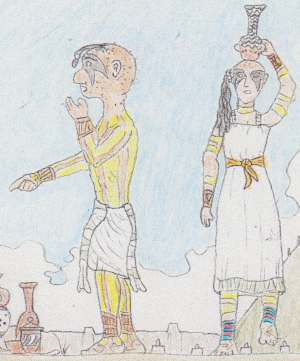
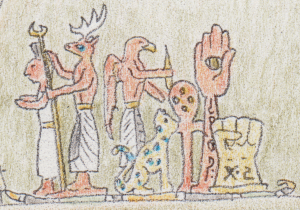
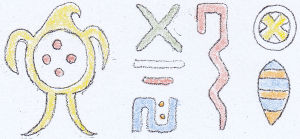
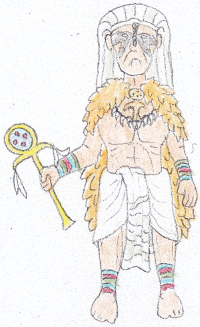
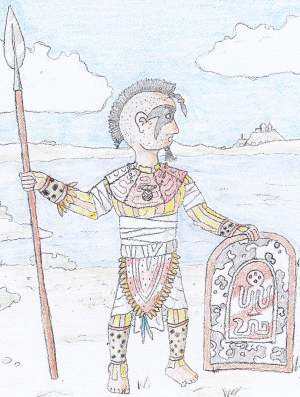

I love the idea of your world, with its cultural mash-ups. I particuarly liked the details on the Galkan writing system and how it evolved via other cultures, as well as the notes on the body paint. Great pictures!